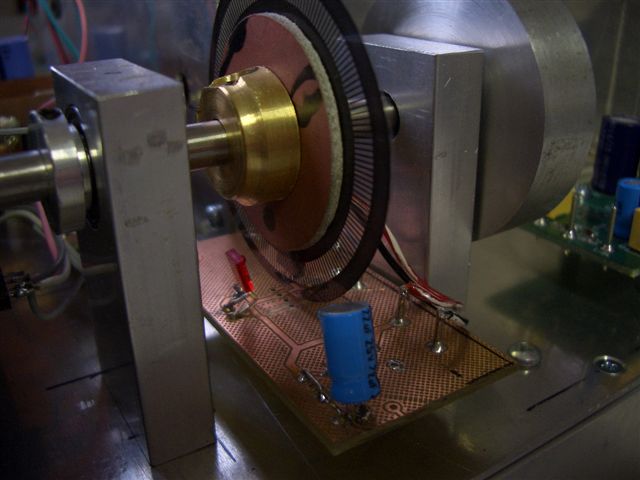
STAR ENCODER WHEEL
PIC-A-STAR is an Amateur Radio transceiver based around a DSP engine (an ADSP-2181).
PIC-A-STAR (Software Transmitter and Receiver) was first published as an article by the Radio Society of Great Britain in RadCom Aug 2002 to March 2004. Also, as a devoted chapter in the 2006 RSGB Handbook. The author of the project is Peter, G3XJP. See also Yahoo groups.
The STAR rig is a little unique in that it uses a home brew optical encoder, which is the only front panel variable control. The parameter to be changed, be it frequency, volume, DSP filters etc, is selected by a keyboard. In normal use though, the front panel variable control changes the frequency that the rig is tuned to, so a smooth action is very desirable.
This presents a bit of a physical challenge in the mechanics of the control as a decent knob is required, driving via a shaft to an optical encoder using an IR LED emitter and a detector. After a unsuccessful attempt at PCB based based bearings etc, I decided to bite the bullet and make a system using proper roller bearings. A visit to my local bearing house, produced a couple of tiny (expensive) bearings that slipped straight onto a piece of nice 1/4" shaft I salvaged from some old test equipment. My STAR case is home made using pieces of 25 x 12mm aluminium bar stock as the base. So i used some short pieces of that and with the lathe, bored some close fitting housings for the bearings. A section of scrap 2" diameter alumimiun was also turned to make a flywheel. Some retaining bushes fit either end, to stop end movement of the shaft. The actual optical disk I made by laser printing on overhead transparency material. A print shop made some for me also but they proved not to be IR transparent and were useless.
The front panel knob I used was a 52mm one from an old Eddystone project.
Reading the data sheet for the HLC2705 IR detector (RS 196-993), showed that the best diode to use with it is the SEP8506 (RS 195-798) so I used one of them also after trying other IR diodes with limited success. (I could not get the LD271 diode used in the original STAR project)
I seem to be getting the odd random frequency change though, after a quick rotation of the dial. It is stopped by moving the dial again. It seems my wheel combination is perhaps better in one direction than the other. i.e.. I don't get equal frequency changes in each direction. This may be a clue, I am not sure yet. I noticed on the data sheet for the HLC2705 that the requirement for the "spokes" on the optical wheel may not be met by the published wheel file. I made a new wheel with thicker spokes. They are now about 17mils wide, slightly wider than the transparent section, which is the reverse to the original design. I have not tried this one as yet, though. If you want to see the new wheel, here is a pdf file of it. to 1:1 scale. It has 180 spokes as per the original STAR design file. Viewing of the pdf file seems to show some "thick" spokes but is an optical illusion. Printing the file shows it is fine.
Here are some pictures of my mechanics for the wheel assembly. It has the original opto transparency. I need to make a new centre bush, to better support the wheel to a bigger diameter as i have some wobble in the material due to the heat from the Laser print process.

Complete assembly of bearing supports and opto wheel. You can see the SEP8506 IR LED here. It's a side looking type package. I made a separate PCB for the opto assembly.

Some detail of the bearing support. The small ball bearing (visible to right of the collar) is contained in a pocket turned into the side of the 25 x 12mm bar (1" x 0.5") The bar is tapped on the bottom end, for screwing down to the chassis. The little collar on there is held with a grub screw and stops end float. It has a shoulder on it to contact the centre section of the bearing. (see previous picture) The flywheel at the rear (previous picture) also stops end float in the other direction. The whole assembly is longer than original STAR design but my chassis is a bit bigger anyway, so no problems.
VK3PE
Uploaded August 8, 2017